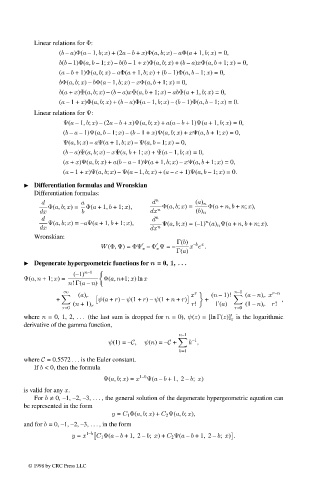Page 785 - Handbook Of Integral Equations
P. 785
Linear relations for Φ:
(b – a)Φ(a – 1, b; x)+(2a – b + x)Φ(a, b; x) – aΦ(a +1, b; x)=0,
b(b – 1)Φ(a, b – 1; x) – b(b – 1+ x)Φ(a, b; x)+(b – a)xΦ(a, b +1; x)=0,
(a – b +1)Φ(a, b; x) – aΦ(a +1, b; x)+(b – 1)Φ(a, b – 1; x)=0,
bΦ(a, b; x) – bΦ(a – 1, b; x) – xΦ(a, b +1; x)=0,
b(a + x)Φ(a, b; x) – (b – a)xΦ(a, b +1; x) – abΦ(a +1, b; x)=0,
(a – 1+ x)Φ(a, b; x)+(b – a)Φ(a – 1, b; x) – (b – 1)Φ(a, b – 1; x)=0.
Linear relations for Ψ:
Ψ(a – 1, b; x) – (2a – b + x)Ψ(a, b; x)+ a(a – b +1)Ψ(a +1, b; x)=0,
(b – a – 1)Ψ(a, b – 1; x) – (b – 1+ x)Ψ(a, b; x)+ xΨ(a, b +1; x)=0,
Ψ(a, b; x) – aΨ(a +1, b; x) – Ψ(a, b – 1; x)=0,
(b – a)Ψ(a, b; x) – xΨ(a, b +1; x)+ Ψ(a – 1, b; x)=0,
(a + x)Ψ(a, b; x)+ a(b – a – 1)Ψ(a +1, b; x) – xΨ(a, b +1; x)=0,
(a – 1+ x)Ψ(a, b; x) – Ψ(a – 1, b; x)+(a – c +1)Ψ(a, b – 1; x)=0.
Differentiation formulas and Wronskian
Differentiation formulas:
d a d n (a) n
Φ(a, b; x)= Φ(a +1, b +1; x), n Φ(a, b; x)= Φ(a + n, b + n; x),
dx b dx (b) n
d d n n
Ψ(a, b; x)= –aΨ(a +1, b +1; x), Ψ(a, b; x)=(–1) (a) n Ψ(a + n, b + n; x).
dx dx n
Wronskian:
Γ(b) –b x
W(Φ, Ψ)= ΦΨ – Φ Ψ = – x e .
x
x
Γ(a)
Degenerate hypergeometric functions for n =0, 1, ...
(–1) n–1
Ψ(a, n +1; x)= Φ(a, n+1; x)ln x
n! Γ(a – n)
∞ r n–1 r–n
(a) r
x (n – 1)! (a – n) r x
+ ψ(a + r) – ψ(1 + r) – ψ(1 + n + r) + ,
(n +1) r r! Γ(a) (1 – n) r r!
r=0 r=0
where n =0, 1, 2, ... (the last sum is dropped for n = 0), ψ(z) = [ln Γ(z)] is the logarithmic
z
derivative of the gamma function,
n–1
–1
ψ(1) = –C, ψ(n)= –C + k ,
k=1
where C = 0.5572 ... is the Euler constant.
If b < 0, then the formula
Ψ(a, b; x)= x 1–b Ψ(a – b +1, 2 – b; x)
is valid for any x.
For b ≠ 0, –1, –2, –3, ... , the general solution of the degenerate hypergeometric equation can
be represented in the form
y = C 1 Φ(a, b; x)+ C 2 Ψ(a, b; x),
and for b =0, –1, –2, –3, ... , in the form
y = x 1–b C 1 Φ(a – b +1, 2 – b; x)+ C 2 Ψ(a – b +1, 2 – b; x) .
© 1998 by CRC Press LLC
© 1998 by CRC Press LLC
Page 770

